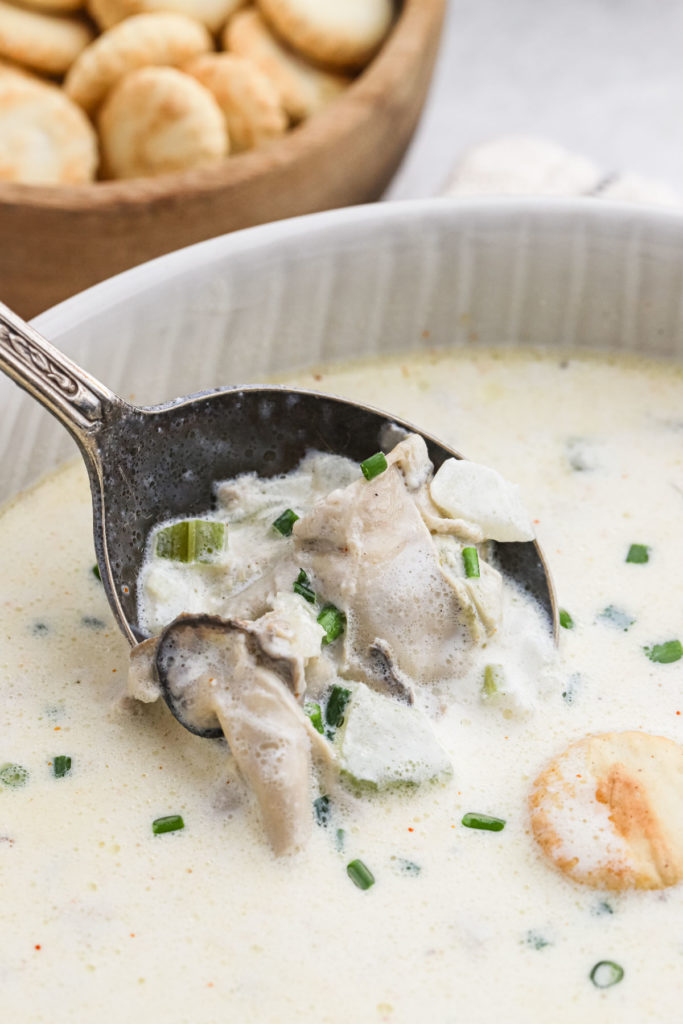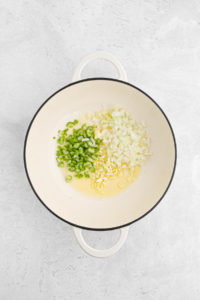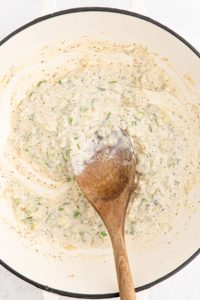Warm up your evenings with a bowl of delicious oyster stew! This creamy stew, brimming with juicy oysters, is a celebration of flavors from the sea, perfectly blended with mild spices. A traditional delicacy, this stew is not just soulful but also easy to whip up for a comforting meal. Try this hearty gumbo if you love stews like this.

Oysters have been cherished for their rich taste and nutritional benefits for ages. This oyster stew recipe pays homage to this seafood marvel, guaranteeing a restaurant-quality experience in the coziness of your own kitchen.
Why you’ll love this oyster stew recipe
- Rich and succulent flavors of oysters
- Creamy and perfect for chilly days
- This oyster stew recipe is high quality, creating a restaurant worthy dish at home.
Ingredients to make oyster stew
- Unsalted butter – Butter is used for sautéing the vegetables, which helps in releasing their flavors.
- Yellow onion – Onions are important in developing the base flavor of many dishes. When sautéed, they add a sweet and aromatic depth to the stew.
- Celery – Celery adds a fresh, slightly earthy flavor and a crunchy texture.
- Clove garlic – Garlic introduces a pungent and aromatic flavor, which complements and deepens the overall taste profile of the dish.
- Celery salt – While providing a touch of saltiness, celery salt also brings in an undertone of celery flavor, reinforcing the fresh taste of celery.
- Black pepper – Black pepper adds a mild heat to the dish.
- Cayenne pepper – Cayenne pepper brings a more intense heat compared to black pepper. This warmth can elevate the flavors and provide a kick to the stew.
- All-purpose flour – Flour acts as a thickening agent when combined with butter and the liquid.
- Half and half – Half and half introduces richness and creaminess to the stew, making it more indulgent.
- Raw oysters packed in their brine – Though there’s nothing quite the same as fresh oysters, you can use canned oysters in a pinch. If using canned, add 1 tablespoon clam juice and add oysters at the very end and heat through for 3-4 minutes, as canned oysters are already cooked.
- Worcestershire sauce – This sauce contributes a tangy, savory depth, with undertones of molasses, vinegar, and tamarind.
- Chives – Chives bring a mild onion-like flavor and a bright, fresh aroma. They also add a splash of color, enhancing the visual appeal of the dish.
How to make oyster stew
- Melt butter in a saucepan over medium heat. Add onion, celery, and garlic and cook until translucent, about 4-5 minutes. Add in celery salt, black pepper, and cayenne, and cook for 30 seconds.


- Sprinkle in flour and cook for 1 minute. Slowly stream in half and half, about ¼ cup at a time, stirring vigorously to ensure a smooth paste. Once all the half and half has been added, bring to a gentle simmer and continue cooking for about 7-8 minutes, stirring occasionally. Do not let come to a boil, as milk will curdle.


- Add in oysters and their brine and cook until the thin edges of the oysters start to ruffle, about 5-6 minutes. Stir in Worcestershire sauce and taste for seasoning. Finish with chives and serve immediately with crusty bread or oyster crackers.

Tips for making the best oyster stew recipe
- Always use fresh oysters for the best flavor: Fresh oysters bring out the most authentic taste of the sea. When fresh, these mollusks offer a briny, sweet, and tender profile that’s unmistakably oceanic. On the other hand, older or poorly stored oysters can introduce an off-putting flavor or even present health risks. Using fresh oysters ensures not only the best taste but also the safest eating experience.
- Avoid boiling the milk to prevent it from curdling: When milk is subjected to high temperatures, the proteins within it can denature and coagulate, causing a curdled texture. This curdling not only impacts the visual appeal of your stew but can also create a grainy mouthfeel. To maintain the smooth, creamy consistency that makes oyster stew so delightful, it’s important to heat the milk gently and avoid letting it boil.
- Add the seasoning gradually and adjust to taste: Seasoning is a delicate art. By adding it in increments, you can monitor the flavor profile and ensure that it aligns with your preference. Especially with dishes like oyster stew, where the primary ingredient (oysters) already carries a natural saltiness, it’s easy to over-season if you’re not careful. Gradual seasoning allows for a balanced taste that enhances, rather than overpowers, the natural flavors of the ingredients.
- For added depth, a splash of white wine can be introduced: White wine, particularly one with crisp acidity, can introduce an added layer of complexity to the stew. The acidity of the wine can cut through the creaminess of the stew, offering a refreshing contrast. When adding wine, choose one that you’d enjoy drinking, and make sure to cook off the alcohol to leave behind only the rich flavors.
Popular substitutions & additions
- Substitute half and half with heavy cream for a richer texture: Half and half provides a creamy base for the oyster stew, but if you’re looking for a more decadent experience, heavy cream is a suitable choice. Or if you simply don’t have half and half, and only heavy cream, you can thin the cream out with milk creating a half-and-half substitute.
- Add diced potatoes or carrots for added bulk and flavor: Potatoes and carrots are classic additions to many stews and for good reason. Potatoes absorb flavors wonderfully and contribute a hearty, comforting texture that complements the tender oysters. Their starchy nature also helps thicken the broth slightly. Carrots, on the other hand, introduce a subtle aromatic freshness. Its crunchy texture can add a delightful contrast to the creamy stew, and its earthy taste can beautifully balance the brininess of the oysters.
- Use herbs like thyme or rosemary for a different aroma: Herbs have the magical ability to transform the aroma profile of a dish. Thyme, with its slightly minty and earthy undertones, can add a layer of depth to the stew without overpowering the oysters. Rosemary, with its strong pine-like fragrance, should be used sparingly but can introduce a Mediterranean flair to the stew. Both herbs can create a more sophisticated taste profile, making the dish even more memorable.
- For a spicy kick, add diced jalapeños or red pepper flakes: While the traditional oyster stew leans towards a milder flavor, introducing a bit of heat can be a game-changer for those who love spicy food. Diced jalapeños not only bring heat but also a fresh, green flavor. For those who prefer a drier heat without additional moisture, red pepper flakes are an excellent choice. They evenly distribute spicy warmth throughout the stew. Remember, a little goes a long way with these spicy additions, so add gradually and taste as you go!
What to serve with this oyster stew recipe
Crusty bread – Serving crusty bread is perfect for a creamy stew such as this. Let the dryer bread soak up any leftover bits in your bowl.
Cornbread with Creamed Corn – A wonderful side with delicious flavor and texture that will complement your oyster stew so well.
Collard greens – Whip up some tender collard greens in the instant pot while preparing your stew.
Harvest Fall Salad – A perfect hearty yet fresh side salad for a rich and flavorful oyster stew.
How to store & reheat our oyster stew recipe
How long will oyster stew last in the fridge?
Freshly made oyster stew, when cooled to room temperature and promptly stored in an airtight container, can be kept in the refrigerator for up to 2 days. The airtight environment helps in retaining the stew’s moisture and flavor. Remember, seafood is more perishable than many other foods. The two-day window ensures that you consume the stew while it’s still fresh and at its best, both in terms of taste and food safety.
Can I freeze our oyster stew recipe?
With oyster stew, there are a couple of factors to consider before freezing. The dairy base in the stew can separate or become grainy once frozen and then thawed. Oysters, being delicate, might lose some of their tender texture once frozen. That said, if you decide to freeze your stew, ensure the stew has cooled to room temperature before transferring it to a freezer-safe container. Souper Cubes are great for storing soups and stews.
When you’re ready to enjoy it again, thaw the stew in the refrigerator overnight. Reheat gently on the stove over low to medium heat, stirring occasionally to prevent any potential separation. For the best flavor and texture, aim to consume the frozen stew within a month.
Frequently asked questions
- What is the difference between oyster soup, stew, and chowder?
All three—soup, stew, and chowder—are dishes that incorporate oysters, but they differ in consistency, preparation, and sometimes ingredients.
Oyster Soup: Typically, oyster soup has a thinner consistency compared to stews and chowders. It focuses on the clear and briny flavor of the oysters, often using a broth base, and may or may not include dairy.
Oyster Stew: Oyster stew is creamier than oyster soup, mainly due to the addition of milk or cream. The primary ingredient remains the oysters, but the overall dish is richer, with a thicker consistency, making it heartier than its soup counterpart.
Oyster Chowder: Chowders are even thicker and often include other ingredients like potatoes, celery, and sometimes even bacon or ham. The broth in a chowder is typically made creamy with milk or cream, and it might also have a roux base to further thicken it. While oysters can be the star of an oyster chowder, they share the stage with other ingredients, making the dish more diverse in flavor and texture.
- Can I use canned oysters?
Yes, canned oysters can be used as a convenient alternative to fresh oysters. While fresh oysters provide a more pronounced briny and sea flavor, canned oysters have the advantage of longer shelf life and are often pre-cooked, making them easier to use. However, it’s important to note that canned oysters might have a slightly different texture and saltiness. If using canned oysters in recipes that call for fresh ones, it’s recommended to adjust the seasoning accordingly and reduce the cooking time to avoid overcooking the oysters.
- What is the traditions behind Oyster Stew?
Oyster stew holds a special place in many cultures, especially in the United States. It’s often associated with Christmas Eve. The tradition of serving oyster stew during the holidays can be traced back to European immigrants who settled in America. For many, seafood was a festive food, and oysters were abundant and affordable, making them a popular choice for celebrations. Over the years, this modest seafood dish has become a cherished part of many family holiday traditions, symbolizing warmth, togetherness, and the bounty of the sea.
More seafood recipes
Oyster Stew
Ingredients
- 2 tbsp unsalted butter
- 1/2 cup yellow onion diced fine
- 1 celery rib diced fine
- 1 garlic clove crushed
- 1/4 tsp celery salt
- 1/4 tsp black pepper
- 1/4 tsp cayenne pepper you can bring down if you don't like the heat
- 1 tbsp all-purpose flour
- 4 cups half and half
- 8 oz fresh raw oysters packed in their brine
- 3/4 tsp worcestershire sauce
- 2 tsp finely minced chives
Instructions
- In a saucepan over medium heat, melt butter. Sauté onion, celery, and garlic until they become translucent, typically taking 4-5 minutes. Stir in celery salt, black pepper, and cayenne, and cook for an additional 30 seconds.
- Dust the mixture with flour and cook for 1 minute. Gradually add half and half, pouring about ¼ cup at a time, while stirring continuously to form a smooth mixture. After incorporating all the half and half, let the mixture simmer gently for about 7-8 minutes, stirring occasionally. Avoid boiling to prevent the milk from curdling.
- Incorporate oysters along with their brine, cooking until the edges of the oysters begin to curl, which takes about 5-6 minutes. Mix in Worcestershire sauce and adjust seasoning as needed. Garnish with chives and serve immediately alongside crusty bread or oyster crackers.

